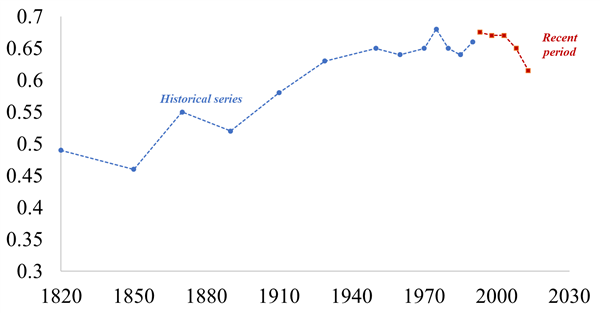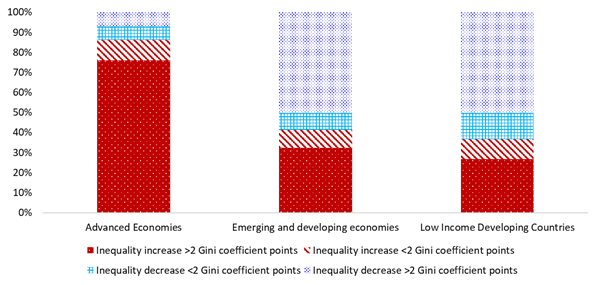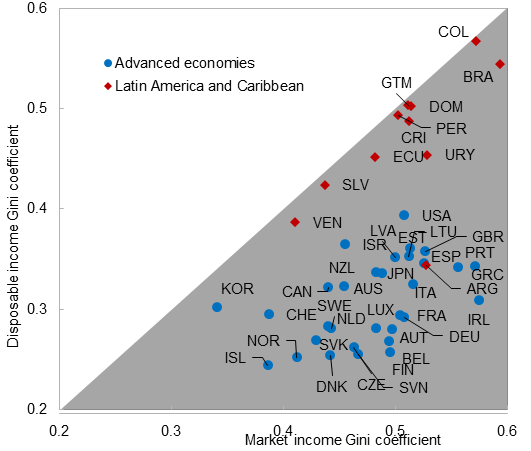What is inequality
Inequality can be viewed from different perspectives, all of which are related. Most common metric is Income Inequality, which refers to the extent to which income is evenly distributed within a population. Related concepts are lifetime Inequality (inequality in incomes for an individual over his or her lifetime), Inequality of Wealth (distribution of wealth across households or individuals at a moment in time), and Inequality of Opportunity (impact on income of circumstances over which individuals have no control, such as family socioeconomic status, gender, or ethnic background). All of these inequality concepts are related and offer different yet complementary insights into the causes and consequences of inequality, hence providing better guidance to governments when designing specific policies aimed at addressing inequality.
How is Income Inequality measured
Gini coefficient is a typical measure of income inequality. The coefficient varies between 0 and 1, with 0 representing perfect equality and 1 perfect inequality. Most of the analysis is centered on the concept of income inequality as captured by the Gini coefficient, which is available for a large number of countries and relatively long periods. Unless specified otherwise, Gini income inequality refers to disposable income or consumption and thus already reflects any redistribution through taxes and transfers.
Figure. Gini Coefficient of Inequality
What Causes Inequality
A range of global and domestic factors — which may reinforce each other — have been proposed in the theory and empirical literature to account for the income inequality trends. The key forces include the following:
- Global factors, such as technological progress, globalization, and commodity price cycles, play an important role. For instance, technological advancement has contributed to the skill premium, because individuals with higher education have a comparative advantage in using new technologies (Card and DiNardo, 2002). In Western Europe and the United States, technological progress has also translated into a hollowing out of middle-class jobs, a phenomenon known as job polarization (Goos and Manning, 2007).
- Country-specific factors, such as those related to economic developments and economic stability as well as to domestic policies — including financial integration, redistributive fiscal policies, and liberalization and deregulation of labor and product markets — also play an important role in explaining inequality trends within countries.
What are Consequences of Inequality
While some inequality is inevitable in a market-based economic system as a result of differences in talent, effort, and luck, excessive inequality could erode social cohesion, lead to political polarization, and ultimately lower economic growth (Berg and Ostry, 2011; Rodrik 1999). But when is inequality excessive? There is no easy answer, but it will depend on several country-specific factors, including the growth context in which inequality arises, along with societal preferences.Basic Facts About Income Inequality
- Global inequality has been declining fast since 1990s. During the nineteenth and most of the twentieth centuries, global inequality increased dramatically, reflecting widening disparities between countries’ per capita income as advanced economies took off sharply compared with the rest of the world. The revival in global economic cooperation in the middle twentieth century ushered in an era of growth and development. Subsequently, per capita GDP growth rates accelerated in less developed countries, particularly in Asia, resulting in convergence in income levels across countries (Bourguignon, 2015). Millions of households were lifted out of poverty. As a result, the global income inequality first stabilized and then started to rapidly decline over the last three decades. However, it should be noted that not all regions of the world experience income convergences with more developed countries. In Sub-Saharan Africa, for instance, income growth on average was more modest than in Asia. Some gains in the reduction of global inequality are likely to be reversed as a result of the COVID-19 crisis. It will likely deteriorate global inequality because advanced economies, in general, have more resources to deal with the fallout from the pandemic and the ensuing recovery effort.
Figure. Global Income Inequality (Gini coefficient)
Sources: Historical series are from Van Zaden and others (2014), who build on Bourgui-gnon and Morrisson (2002). Recent data is from Lakner and Milanovich (2013).
- Within-country inequality has risen in most countries. While the progress in the reduction of global inequality over the last thirty years has been remarkable, within country inequalities have increased, especially in advanced economies. Over the past three decades, more than half of the countries and close to 90 percent of advanced economies have seen an increase in income inequality, with some countries recording an increase in their Gini coefficients exceeding two points. Some of key factors behind the increase in within-country income inequality noted in the literature include technological progress, globalization, commodity price cycles, and domestic economic policies such as redistributive fiscal policies, labor and product market policies.
Figure. Change in Income Inequality, 1985-2015 (percent of countries)
Source: IMF, Fiscal Monitor, October 2017
- Rising social spending has been used to combat inequality. Fiscal policy is a key policy instrument available to governments to achieve their distributional objectives. In advanced economies, taxes and transfers decrease income inequality by one-third, with most of this being achieved via public social spending (such as pensions and family benefits) (Immervoll and rel="noopener noreferrer" others 2005; Paulus and others 2009). The extent of fiscal redistribution is even higher if the redistributive impact of in-kind spending rel="noopener noreferrer" (such as education rel="noopener noreferrer" and health) is included (Paulus, Sutherland, and Tsakloglou, 2009). Thus, it is important to ensure that social spending is adequate, effective and sustainable. Progressive income taxes also play an important redistributive function in some countries. The lower redistributive impact of fiscal policy in developing economies is also a key factor behind their high levels of inequality.
Figure. Redistributive Impact of Income Taxes and Transfers, 2015 or Latest Year
Source: IMF Fiscal Monitor, October 2017.
IMF and Income Inequality
Inequality is at the center stage of economic policy debate across the globe. A fair and equitable distribution of income is a fundamental element of the social contract. Macroeconomic policies (including government tax and spending policies) have significant effects on income distribution and that inequality can have adverse political and social consequences, with the potential to undermine macroeconomic stability and sustainable growth.
Inequality is thus, without any surprise, an important issue for the IMF in all three of its core activities:
(1) lending to support macroeconomic adjustment programs;
(2) macroeconomic surveillance, including related policy analysis; and
(3) technical assistance to build capacity, especially on government taxation and spending.
Historically, distributive issues have been an important part of the IMF’s dialogue with member countries. Work on them has especially intensified in the wake of the global financial crisis that began in 2008.
IMF work on income inequality before the global financial crisis that began in 2008 was particularly influenced by the experience gained from IMF-supported programs. In practice, this experience led to greater attention to integrating social safety nets into adjustment programs and safeguarding access to basic public services in health and education. Other initiatives, such as the introduction of the Poverty Reduction and Growth Facility in 1999, brought growth and poverty reduction objectives to the center of program design in low-income countries, as did the Heavily Indebted Poor Countries debt-relief initiative. IMF-supported programs were successful in raising social spending, including in comparison with similar countries without programs.
The IMF has further deepened its work on inequality issues in the years since the beginning of the global financial crisis. This effort has encompassed an expansion of both cross-country analytical studies and country-level assessments of fiscal consolidation and inequality, a variety of fiscal policy instruments to achieve equity goals in an efficient manner, and the macroeconomic gains from strengthening gender equity. An important lesson is that with the right design, government tax and spending policies can help achieve both stronger growth and greater equality of outcomes and opportunities. For example, boosting access to basic health and education services and reducing barriers to female labor market participation can help raise growth and meet equity objectives. Even in the design of fiscal consolidation, a number of options can help reduce budget deficits without aggravating inequality. These include measures to raise revenues from income taxes and targeted (rather than across-the-board) reductions in social benefits. Measures that are good for both equity and efficiency — for example, an increase in revenues from recurrent property taxation — should also be given strong consideration when designing fiscal consolidation packages.
The IMF will continue to strengthen its analytical work on income distribution issues. These efforts will involve further cross-country analysis on different aspects of macroeconomic policies and how they affect income distribution. Work at the country level on income distribution issues will also be deepened. The approach will be selective, and it will be concentrated on countries where these issues are critical. The IMF expects considerable synergies between country-level and cross-country analysis, and the IMF will continue to draw on the profession’s work in these areas. In sum, the IMF will continue to deepen understanding of the nexus between income distribution and macroeconomics, with the goal of providing relevant policy advice.
With the expected increase in income inequality as a result of the COVID-19 pandemic the IMF’s work on inequality issues is expected to become even more intense.







